|
TennisOne Lessons Getting a Grip on Good Contact: The Anatomy of a Catch Doug King Many people say that tennis is not so much a hitting game as it is a running game. I would agree with that statement to some extent, but I would suggest that a better way to put it is that tennis is more of a catching game than a throwing game. (Notice that I replaced the word hitting with throwing since hitting is actually a throwing motion.) In the case of tennis it is throwing the racquet at the oncoming ball. But throwing the racquet at the ball (or hitting the ball) is not the difficult part of the game. The tough part is catching the ball; or if you prefer, “meeting” the ball. Of course the throw of the ball is the end result but the more difficult part is the run and catch of the ball, hence the emphasis on that aspect.
Think of it this way; we often compare tennis to the game of baseball. We look at how a batter lines up his stance, how he winds and unwinds the hips and shoulders, how he keeps his head down and follows through. But in my mind we are looking at the wrong player… we shouldn’t be looking so much at the batter but instead be looking at the shortstop (or any other infielder) to really get a better comparison to show how the two sports are similar. You see, in tennis the player must constantly be on his toes ready to move in any direction. This is much more like an infielder rather than a batter. A baseball batter can dig his feet into position and wait for the pitch. He can hold up the pitcher until he is ready and even let pitches go by that he deems “out of the strike zone.” But a tennis player has to move and think like an infielder. In both cases the player must be ready to move to the right or left, up or back, and he must stay light on his feet and never get planted. He must incorporate a split step at the moment that another player is hitting, followed by positioning steps. He must keep his eye on the ball and get his body behind the ball. In both cases the free hand is critical in maintaining balance and control. (Baseball infielders are always told to catch with both hands and similarly a tennis player must learn how to maintain “form” with the free arm and hand.) An infielder must be alert to get his body in perfect position to field the ball and then throw out a runner in a single, fluid motion. Moving to the ball, watching the ball, judging it, adjusting to the ball and meeting it perfectly is truly the difficult part of tennis. If you stood over a baseball plate with a tennis racquet in hand to hit an oncoming ball that had to be thrown into your strike zone, I assure you that hitting the ball would be relatively easy – and hitting it over the fence would be even easier. But we never have that luxury in tennis. That is not and was never intended to be the challenge of the game. We can’t just dig in and wait for the pitch, and although we try our best to get into optimal position to field the ball we must be very adept at fielding and throwing from any number of “compromised” positions. The Catch and the Throw
The challenge of the game is to run around so that you can meet, grab onto, or “catch” a ball that your opponent is trying to get past you and then throw it precisely to a target. With all of the variations that must be incorporated into the stroking mechanics, whether it be the backswing, stance, or followthrough, the one thing that has no tolerance for variability is the contact of the ball. The ball and the racquet must square up and meet exactly the same in order to produce a consistent result. This “meeting up” or connection between the racquet and the ball should always be the main emphasis of a stroke. And so it is similar to a baseball infielder who has to catch the ball and then throw out a speedy runner; or a football receiver who has to catch a ball and then run with it. The fielder and the receiver must secure the ball before they throw or run or do anything else with the ball. The same applies to tennis. In tennis it is perhaps even more difficult because we have to blend these two opposing motions (the catch and the throw) into a single action with every stroke of the ball, and this requires tremendous coordination. (Of course I have never had to catch a football thrown over the middle while a 250 pound middle linebacker is bearing down on me with the intention of separating my head from the rest of my body. Come to think of it, that might be pretty tough as well.) The truth is that it is impossible to completely separate the “catch” from the “throw” in real play but it may be very helpful to separate them in our minds eye. All top players demonstrate this mental and physical focus on the “catch” of the ball by how they keep their head held back after contact so that their head and their gaze stays fixed in the direction of where the contact occurs. They are staying with the point of contact – that is, they are focusing on the point of where they are meeting or catching the ball and they are controlling the movements of the body so that the body is properly pivoting on and around the contact point. They are not looking up to where they are hitting or throwing the ball. This is because they know that all stroking motion and focus revolves around that single point of contact. It is by aligning their mental focus and their physical movements on the point of contact that allows them to keep their heads fixed to that point as they execute a stroke. This has many more ramifications than simply how they see things. The act of catching involves a very different set of actions and attitudes. It is reactive in mental attitude whereas hitting is active. My friend, a great player and coach, Helle Viragh, once expressed that she saw the game as a conversation between two people. To hold a proper conversation you must be able to both speak and listen. As we all know that is not always that easy to do. Applying the “conversation” analogy to tennis, when you catch you are “listening” to the ball; that is, the ball is telling you what to do and you are reacting to what you are told. When you are hitting the roles are reversed. When you hit you are telling the ball what to do and the ball is following orders.
This is the great beauty and challenge of tennis. It is a totally shared experience between you and your opponent. You have control only over one half of what goes on and your opponent has equal say. You must not only maintain your own rhythm, you must be able to adjust and yield to your opponent’s rhythm. That requires being able to give up control over what goes on, allowing your opponent to have his say. To give up that control over some of the game is often the most difficult part of tennis to master, and for many it becomes the biggest stumbling block (and I include a number of top pros in this group). The harsh reality is that you simply cannot control everything in the game. You cannot bend everything to your will. You must learn how to soften, and listen, and wait, and react. You cannot call all of the shots. This is significant because it reflects the two totally opposing aspects of stroking, the catch and the throw. These skills can be legitimately seen as polar opposites in terms of mental state (attitude) and physical motor actions. Catching is reactive while throwing is active. Catching requires softening movements that collapse into the body while throwing actions require forceful movements that extend out from the body. In the same way that the mind or attitude must be able to become pliable and yield to the opponent, so to must the body be able to yield to the ball in a “catching” feel. Compressing, contracting, and pulling actions bring energy and objects into the body. This is the essence of “catching”, which is absorbing the energy of an object coming at you and drawing that energy out of the object and into the body. In that motion the arms are drawn into the body and the wrists are folded back as the oncoming object makes contact with the hands. Expanding, straightening, and pushing expel energy and objects away from the body. This is how tennis is played by contracting and expanding on the point of contact. Alignment and Compression: The Keys to the Catch If we accept the premise that “meeting” the ball properly is critical to a good stroke, then what is the key to meeting the ball well? Lets look more closely into what constitutes a good “contact” with the ball. Alignment First good contact must include proper alignment between the ball, the racquet and the target. Not only do we have to get them to come into contact with each other but we must get the ball to meet a very specific point on the racquet, the “sweet spot.” This requires a good deal of hand eye coordination (even more than catching a ball with the hand, because although the racquet face is bigger than the hand, the sweet spot is not and the sweet spot is a good deal further away from the body than the hand). But the meeting of the ball and the sweet spot is not the only alignment that is relevant to good contact; there must also be alignment between the body and the contact point, and there must be alignment of the racquet to the target at the moment of contact with the ball. It is my belief that top players are much more conscious of this alignment between the ball the racquet, the body, and the target, than most people think. Most people think that top players are all about generating force, speed, and spin; that they go through the contact like a blur and simply “cock and fire.” I strongly disagree and would argue that everything is more calculated to creating good contact with the ball, and critical to good contact is good alignment. In fact, this ability of top players to consistently create precise alignment between the ball, the racquet, and the target may be the single most critical skill that separates them from lesser players. This aligning of the various elements of the stroke at contact is much more of a delicate adjustment rather than a powering process. In this way it has much more of a “catching” attitude to it. Compression The second part of a good contact of the ball is compression. In my previous three articles I articulated a new model to describe tennis play called the “Wave Model.” Part of what I like about this model is the way that it addresses the concept of catching or meeting the ball. A wave by nature does not collide with objects as much as it “catches” objects in turning actions (you get caught in a wave or a riptide more than you get “hit” by a wave). There is softness to the water of a wave that allows another object to be absorbed into the wave energy. This is an integral part of good stroking.
We should never “hit” or collide with the ball but instead we should absorb the ball into the energy of the motion we are producing. The key to this absorption is compression. When two objects with divergent paths meet there is a collision and an exchange of energy. If there is elasticity or deformation to that collision then there is compression. The more that the objects compress the more time that they stay together, the more time they stay together the more potential torque and drive is available. There is a natural elasticity to the strings and the ball so there is always deformation of the strings and the ball and therefore there is always compression but this can be further manipulated through the hands. This, however, belies the more full body compression just prior to contact with the ball. Just as the ball arrives there is a compressing of the wrist back into the forearm and a compression of the arm into the body, even a compression of the body into the ground (bending the knees and back). These compressions are key to properly drawing energy into the body and also allowing the arms and hands to become more relaxed and “reactive” to the ball. The player, being more relaxed and reactive, can therefore perform a more precise, consistent catch of the ball. Let me explain; most people are too busy swinging and hitting at the ball. They get ready early and then they swing out at the ball. They are very focused on hitting the ball and making it go somewhere. When you are in a “swinging out at the ball” mode the body and arms are stiffening and unable to react or adjust to the incoming ball well. If you cannot adjust to the ball you might as well not be looking at the ball. The result is frequent mis-hitting. This is also why people are always feeling too close to the ball. It is rarely because they are standing too close to the ball or even that they are late. It is almost always that they are too busy swinging out at the ball and simply can’t meet the ball well. If the ball is coming in and you are swinging out on an opposing path you are going to have trouble connecting well – both in terms of the type of contact that you will achieve and because of the inherent timing difficulties.
On the other hand top players are rarely jammed by shots. In fact they often prefer to catch the ball in closer. Notice that I said “catch” the ball in closer – not hit the ball in closer. They have more leverage and stability in close. Andre Agassi was a perfect example of really great technique. He would always let his arms and hands collapse into the body, allowing them to relax and catch on to the ball with more accuracy, stability, and leverage. The hit was applied in just an instant, so soon before the catch that it would give the feeling of actually “holding” the ball and accelerating (or tensing) after the contact. This is why we say “meet the ball first and accelerate later” because our compulsion is to swing out to the ball way too soon. Even the pros make the same exact mistake. When they miss they are almost always going out to hit the ball too soon, hitting the bottom edge of the frame or the tip of the racquet. I still can picture Federer weakly netting a relatively easy forehand on match point against Nadal at Wimbledon, swinging way out in front for the ball rather than moving up to the ball and catching it alongside his body in his usual fashion. Visual Focus and Catching the Ball Catching the ball may sound easy but it can be tricky. It requires more relaxation, more flexibility, bending and coiling. and softening. It requires more patience and focus on the ball. This is especially difficult because we are so conscious of making that little ball go somewhere. We are “seeing” too much of where we want the ball to go, which is a mental form of “over hitting” or having our awareness in too much of a hitting mode. Much of our focus on the ball in tennis is anticipatory in nature; that is we are visualizing where the ball is going to go. When the ball is hit at us we judge where the ball will be when we contact it. Before we hit it, we plan where we want the ball to go after we hit it. But when we go into contact with the ball we must suspend this mode of projecting ahead of the ball and instead slip into a retentive focus with the ball. As the ball approaches contact we need to look at it in real time and stop thinking of where it is going to be. And as we contact the ball we actually go into retentive focus, we look back at where the ball was when we made contact with it.
Catching a ball is a much more “real time” and retentive focus oriented act since we don’t have any future plans for the ball other than “meeting” it. This shift between judging the ball and planning a shot in a future oriented focus and then actually stroking the ball in a retentive focus is a tricky adjustment to master. It takes a great deal of mental acuity and timing, a light and facile side step of one’s “mental stance” or posture, so to speak, and it is at the heart of watching the ball well. Another way of putting it is that we must focus on meeting the ball squarely before we start worrying about hitting it somewhere. Racquet Head Speed and Catching the Ball Based upon my previous statements it should be no surprise that I am not a real advocate of racquet head speed. If you look at good players, you will actually see quite the opposite, you will see the racquet head folding back and stabilizing in the wrist and to the target. One thing that all top players do that is markedly different than recreational players is that they stabilize the wrist and hold alignment to the target through contact. Most recreational players are swinging the racquet with their hands far too much. A funny thing happens when you use the hands to increase the speed in the racquet head and that is that the wrist gets weaker and the racquet loses stability and alignment. When the wrist is pushed backwards it gets stronger and more stable. You can feel this by simply pushing back on your finger tips so that the wrist folds back and you can feel how the wrist stabilizes and firms up. When the ball hits the racquet with the wrist in this position the response is more accurate and stable. When the wrist is snapped forward the wrist actually weakens and becomes less stable.
Two other things break down when the wrist is snapped forward; one is that there is less compression between the ball and the racquet and therefore a good catch of the ball becomes much less likely and secondly the racquet is quickly snapped out of alignment to the target so the player loses directional control. So the real key to good contact is to allow the racquet head to become passive to the thrust of the body. I like to tell my students to feel as though the arm is pushed through the racquet head much like how a snake would push though it’s skin while molting. The racquet head is pushed backwards by the ball and is left behind while the arm is pushed through. This enhances compression with the ball, stability in the wrist, and accuracy of alignment to the target – all keys to good contact. Instead of trying to increase racquet head speed, or swing the racquet head through the ball, try instead to let the ball push the racquet backwards in your hand. Try to experience the compression of the ball in the strings, even enhance the compression by letting the wrist compress back into the arm. This will actually improve your contact with the ball (a key to power) and the accuracy of your shots. Conclusion Every stroke has a catching and a throwing aspect. The key is to be able to catch before you throw. Even though these aspects get blurred, top players are able to generate force through precise timing, alignment, strength, and flexibility, so that the actual forceful “hitting” of the ball is done quickly and very near the actual contact of the ball. In this way, players are more able to focus on the feel of watching, reacting, and “catching” the ball. I strongly believe that top players are much more conscious of using the racquet to meet the ball and keeping it to the target after contact while average players are much more focused on creating speed in their racquets as they hit at the ball and “following through” and finishing their shots. In the top players it is the body (the legs, back, torso, arms, even hands – everything but the racquet) that is forceful So instead of trying to swing into the ball or hit through the ball, take a moment to first make sure you square up to the ball. Think like a shortstop and make sure you catch before you throw. Your comments are welcome. Let us know what you think about Doug King's article by emailing us here at TennisOne.
Doug is one of the country's foremost tennis teaching innovators. Founder of Acceleration Tennis, a revolutionary teaching system, King is leading the way in reinterpreting the traditional tennis model. Doug King is currently Director of Tennis at Meadowood Napa Valley ( www.meadowood.com ), a Relaix Chateau Resort in St. Helena , CA . For more information on Acceleration Tennis please email Doug King at dking@meadowood.com. |
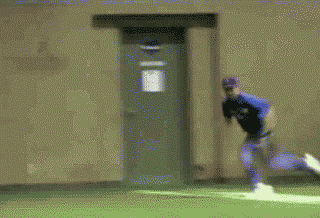
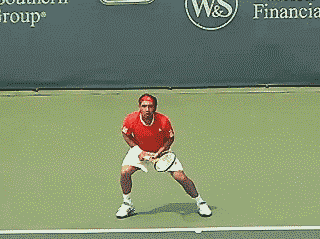
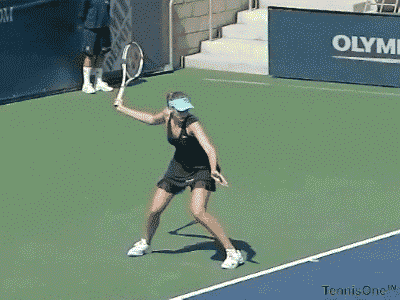
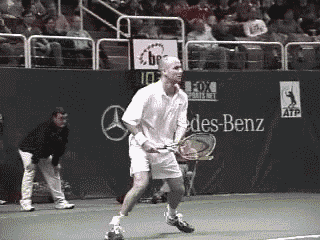
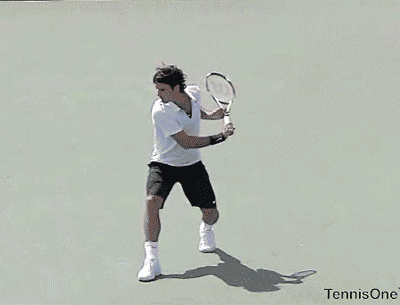
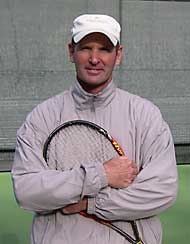
 Doug King studied with legendary tennis coach Tom Stow and was a
former California State Men's Singles Champion
and the former number one men's player of Northern California.
Doug King studied with legendary tennis coach Tom Stow and was a
former California State Men's Singles Champion
and the former number one men's player of Northern California.